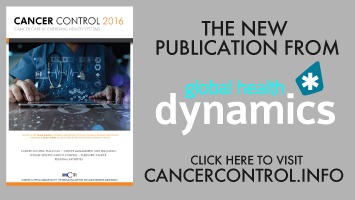Interview: Malin Grape
AMR Control interviews Malin Grape, the newly appointed and first Swedish Ambassador for Antimicrobial Resistance
The new AMR Ambassador, Malin Grape, is currently head of the Public Health Agency of Sweden’s Unit for Antibiotics and Infection Control and has long worked on these issues, both nationally and internationally. She was responsible for the Public Health Agency’s work to build and develop the WHO’s Global Antimicrobial Resistance and Use Surveillance System (GLASS) and also worked on the European Joint Action on Antimicrobial Resistance and Healthcare-Associated Infections (JAMRAI) project.
AMR Control: Please tell us how you became involved in antimicrobial resistance (AMR)?
Malin Grape: My first encounter with AMR was when I did my Master’s thesis and was invited to the clinical microbiology laboratory at Karolinska University Hospital to start up a study on molecular resistance mechanisms in urinary tract infections. The complexity of the issue sparked my interest; the span from molecular microbiology to policy, behavioural science and health economy intrigued me. Though my experience in public health has broadened, this interdisciplinarity is what still keeps my curiosity and engagement in the topic.
AMR Control: Can you explain the reasons that led the Swedish Government to establish this important position of AMR Ambassador? What is the nature of the role and how will your ambassadorship fit into the existing network of organizations involved in AMR?
Malin Grape: AMR has been a priority for the Swedish health professional community and the Government for many years. In 1986, we banned the use of antibiotics for growth promotion in animals, the first Swedish national strategic stewardship programme, Strama, started in 1995 and our first cross-sectorial national action plan on AMR was published in 2000. Hence, it is only natural that new steps continue to be taken; my country has high ambitions and a long-standing commitment to the fight against AMR. What I particularly appreciate with the appointment of this role is the focus on how we may contribute more in the international arena. The aim is to strengthen the Swedish AMR work internationally, both in regarding bilateral exchange and support, with multilateral organizations and the United Nations and within the European Union.
AMR Control: What will be your first steps in the role?
Malin Grape: The first months have been a lot about re-connecting and establishing my network in the area in the wake of the pandemic. Most of us working with AMR have been busy with hands-on pandemic management and it has been a real pleasure to again meet colleagues from around the world and talk about AMR and what lessons can be brought from COVID-19 to tackle AMR. Furthermore, I have “jumpstarted” our preparations for the Swedish EU presidency in 2023, during which AMR will be a priority topic.
AMR Control: This edition of AMR Control has a special focus on the cancer community and AMR. Do you have any specific thoughts on how this community can help with the challenge of AMR?
Malin Grape: AMR is relevant for so many more areas than most people currently recognize. Even in Sweden, where work to counteract AMR gets quite a lot of attention, it is not by default on the radar of many oncologists as an issue that urgently concerns them. The cancer community is an important and vocal group that can contribute by showing how AMR is relevant to us all and support the increase in awareness that is necessary to achieve sufficient action.
AMR Control: Some have called AMR the “silent” or “quiet” pandemic. Do you think the COVID-19 pandemic has helped or hindered progress on tackling AMR?
Malin Grape: Of course, during the most intense period of COVID-19 not much attention could be given to AMR, being a much more slowly developing pandemic. In that sense, as for many other areas, it has been two years lost and a boost in the momentum of our work is now critical. On the other hand, I think that the general awareness and understanding of communicable diseases and their prevention has increased immensely in the public and this is an opportunity we must use. Hand hygiene and infection control have never been the hottest topics, but they will probably never be hotter than now. I regard this awareness as a window of opportunity, which, if used wisely, may contribute to more resilient health systems with a stronger focus on prevention. Hospitals will always be the most important risk environments for the spread of resistant microorganisms, with susceptible patients and lots of antimicrobials being used giving the resistant microbes a clear competitive advantage. This is a chance to maintain and strengthen the IPC (infection prevention and control) programmes that might not come back in the near future. It is also important to understand that the responsible use of antimicrobials will never in itself be enough to curb the negative development of AMR.
Also, the very necessary and life-saving use of antimicrobials drives resistance and we need to become better at preventing the spread, both of resistant microorganisms and the infections that require antimicrobial treatment.
AMR Control: In what ways do you see AMR as a global health security threat?
Malin Grape: We haven’t yet seen the full consequences of AMR for public health, but the current context of cancer illustrates very well how it may have devastating effects on both modern advanced medicine and public health development in low- and middle-income countries. With its One Health characteristics and ability to effectively spread around the globe it is also an obvious part of pandemic threats and should be included in systems strengthening aiming at pandemic prevention, preparedness, detection and response.
I think it is important though, not to limit the description of AMR as only a health security issue when it is also a sustainability issue, an equity issue and a development issue. It is essentially a threat not only to the Agenda 2030 third goal of health and wellbeing but concerns the achievement and should be mainstreamed into the work towards several of the sustainable development goals.
AMR Control: What do you think are the greatest barriers to overcoming AMR?
Malin Grape: AMR is a kind of tragedy of scale. If it is only prioritized and counteracted by a few, then the curve is unlikely to turn. Right now, we need more countries and stakeholders to give AMR higher priority. And to ensure that the response is fully capitalized on, much more effective coordination and stronger governance is needed. Another lesson learnt from the pandemic is the matter of visibility. When numbers are reported daily, and everybody acknowledges the threat, powerful action is easily generated. But AMR concerns so many different diseases of varying seriousness and has so many faces that the same response will not be achieved straightforwardly. The general awareness that AMR concerns all of us must therefore be increased. The measures to prevent and tackle AMR need to be integrated into health and many other policy areas rather than managed within a silo as a separate, isolated problem.
Like climate change, AMR is not something threatening us in a gloomy future, but a problem here and now. Already, the 1.27 million deaths in 2019 resulting from bacterial infections resistant to antibiotics is greater than those caused by AIDS and malaria annually.
AMR Control: How do you see the role of NGO, academia and industry partnerships in addressing AMR?
Malin Grape: All sectors of society need to contribute from their own angle and ensure that we collaborate towards common goals. Partnerships are important and should be carefully managed to achieve their full potential and avoid becoming skewed towards a certain interest. In the best of worlds, they would also be placed in the context of an overarching coordination effort, assuring connections and synergies with other initiatives. One step towards this is hopefully the forthcoming establishment of the Multi-Stakeholder Partnership Platform on AMR, which is one of the key governance mechanisms recommended by the IACG on AMR to the UN Secretary General in 2019. Another is the One Health Global Leaders Group on AMR, which is up and running with our Swedish Minister of Health and Social Affairs, Lena Hallengren, as vice chair; a third essential pillar in this construction, the Independent Panel of Evidence for Action on AMR, is still worryingly pending.
AMR Control: How do you see AMR developing in 10 years’ time?
Malin Grape: I have to be an optimist and expect that the world’s response will be much stronger than it is now. However, it is not a threat that is easily overcome, but rather something we must learn to live with while preventing and counteracting its consequences as effectively as possible. It is most likely that resistance levels will not be lower in 10 years’ time than our current levels. We should keep in mind that resistance to antimicrobial substances existed long before humans started to use and misuse them, and AMR will never completely disappear. Having said that, I do hope that we can find a much more sustainable way of co-existing with microorganisms – resistant or not – and ensure that finite resources such as antimicrobials are used in a much more responsible way. This is a lot to wish for in 10 years’ time, but if this awareness of antimicrobials as global goods worthy of protection is at least significantly increased over the next decade, then I do have confidence in a future of life-saving prevention and treatment of common and serious infections. n
Malin Grape holds an MSc in Pharmacy and her background is in research. Her doctoral thesis focused on antibiotic resistance. She has worked on antimicrobial resistance both nationally and internationally.
References
1. http://www.bmg.bund.de/fileadmin/dateien/Downloads/G/G7-Ges.Minister_2015/G7_Health_Ministers_Declaration_AMR_and_EBOLA.pdf (accessed Jan 30, 2017)
2. http://www.globaltimes.cn/content/927294.shtml (accessed Jan 30, 2017)
3. Laxminarayan R, Amabile-Cuevas CF, Otto C, et al. UN high-level meeting on antimicrobials—what do we need? Lancet. 2016;388(10041): 218-220
4. http://www.who.int/drugresistance/global_action_plan/en/(accessed Jan 30, 2017)
5. National Health & Family Plan Commission of China, National plan for the containment of antibacterial resistance (2016-2020). http://www.nhfpc.gov.cn/yzygj/s3593/201608/f1ed26a0c8774e1c8fc89dd481ec84d7.shtml (accessed Jan 30, 2017)
6. Liu YY, Wang Y, Walsh TR, et al. Emergence of plasmid-mediated colistin resistance mechanism MCR-1 in animals and human beings in China: a microbiological and molecular biological study. Lancet Infect Dis. 2015;16(2):161-168
7. Zhang QQ, Ying GG, Pan CG, et al. Comprehensive evaluation of antibiotics emission and fate in the river basins of China: source analysis, multimedia modeling, and linkage to bacterial resistance. Environ Sci & Technol. 2015; 49:6772-6782
8. Zhu YG, Johnson TA, Su JQ, et al. Diverse and abundant antibiotic resistance genes in Chinese swine farms. PNAS. 2013;110(9):3435-3400
9. Currie J, Lin WC, Zhang W. Patient knowledge and antibiotic abuse: Evidence from an audit study in China. J Health Economics. 2011;30(5):933-949
10. Boeckel TP, Brower C, Gilbert M, et al. Global trends in antimicrobial use in food animals. PNAS. 2015; 112(18): 5649-5654
11. Yip WCM, Hsiao W, Chen W, et al. Early appraisal of China’s huge and complex health-care reforms. Lancet. 2012;379(9818):833-842
12. Department of Health, Department for Environment Food & Rural Affairs. UK five year antimicrobial resistance strategies 2013 to 2018. Sept. 2013.
13. https://www.whitehouse.gov/sites/default/files/docs/national_action_plan_for_combating_antibotic-resistant_bacteria.pdf (accessed Jan 30, 2017)
14. http://www.jpiamr.eu/jpiamr-and-french-ministry-of-health-to-host-collaborative-talks-between-european-ministries-agencies-and-funding-bodies-in-the-field-of-amr/ (accessed Jan 30, 2017)


